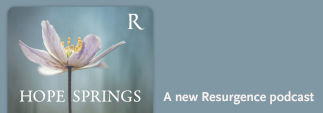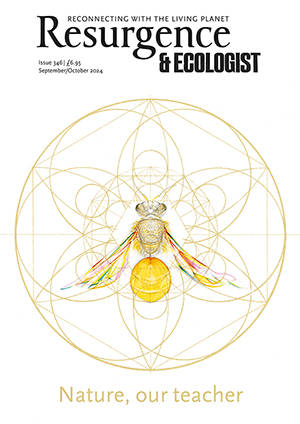A tree’s heartwood is the dense, mature wood found at the centre. It is the oldest part of the tree, which has often observed centuries of life. Rather than non-living, as some biologists have come to define it, I consider heartwood as the embodiment of a collection of deep-rooted memories. These memories have captured the stories of our Earth in the form of particles, communicated in annual tree rings. If we were to look closely, if we were to listen in, we might reach into this cavernous environmental knowledge that has been preserved, alongside the stories told through roots, trunk, branches, blossoms and flowers.
Listening to heartwood and hearing this knowledge takes time, lots of time. It also takes patience. It demands that we sit still and open to discomfort as our perspectives shift. Knowledge not only accumulates from the direct experience of the tree, but is also pulled up through the roots and through the leaves, allowing the well-travelled water droplets and air particles to share their experiences from further afield. When you’ve listened to heartwood, it will often lead to wanting to share the experience with others and to then take action.
Environmental education, including the research and scholarly literatures it has elicited, has much in common with the heartwood of a tree. In The World We’ll Leave Behind, the core book we use on our MA module Environmental Education: Sustainability and Society, Bill Scott and Paul Vare remind us that since the beginning of the biosphere all education was environmental, because our survival rested on this knowledge for our food, our shelter, and our safety.
At the forefront of environmental education were Indigenous peoples. They learnt to listen to the inhale and exhale of the Earth and became attuned to the biosphere’s excesses and famines. Today’s westernised notion of environmental education has its roots in Rachel Carson’s 1962 book Silent Spring, which turned our gaze towards the negative impacts of humans on the Earth’s systems. Over the past fifty years, whilst our environmental and social challenges have become ever more pressing, there has also been an expansion of deep, philosophical academic literatures concerning environmental education, which has similarly grown – indeed, none so much more than in the last decade.
In academia, such scholarly work might be considered as our ‘heartwood’. It holds wisdom, signifiers and way-markers. Similar to the practice of listening into the stories that trees have to tell, scholarly work also requires us to sit still, to listen, and to consider a range of perspectives. This too requires time and patience; it requires guidance.
In a busy and noisy world, time can feel like a scarce resource, and guidance can be challenging to trust. The result is that much work has gone unread, and when it has been read, the readership has been limited to academics, leaving the important messages and calls for action unheard by the majority. This silent neglect can be witnessed in scholarly repetition, as well as in the conservative and regressive policies and research programmes that keep us entrenched in the ‘business as usual’ practices that have arguably brought us to the climate crisis we find today.
Environmental Education: Sustainability and Society
The co-creation of our MA module Environmental Education: Sustainability and Society (later to become Environment, Sustainability and the Role of Education) was a direct response to the need to connect a greater audience to the literatures concerning the complex and multi-faceted field of environmental education. In 2018 I had the privilege of working with Kate Greer, a climate change education policy expert (and all-round good human being), to co-create a Masters degree module for those studying in the field of education, and in particular STEM (Science, Technology, Engineering and Mathematics) Education. The resulting module set out to guide students, many of whom are educators, through the historical, political and philosophical landscape of environmental education academic literature.
We wanted this new module to open up our students’ thinking, going beyond discussions of ‘best practice’ and ‘evidence’, so that they could observe and critique the dominant discourses embedded in contemporary environmental-related education. In doing so, we have navigated the module through the sticky ground of how capitalism has come to shape our engagement with Nature, and the role that international and national policies play in agenda setting, alongside the tensions faced when designing an environmentally just education. In doing so, we mine ideas of activism, educators’ beliefs and self-efficacy, and alternative forms of practice. We provoke conversations concerning organisational responsibilities, including turning the gaze back on ourselves as a higher education institution, to explore how we are stepping up to grapple with global emergencies and to ask whether educators have the capabilities required to respond. In doing this work, we encourage our students to become attuned to and adept in the language required to broker environmental and social divides.
In essence – and akin to tapping maple trees for their syrup – we seek to extract and distil the heartwood of academic literatures. As a consequence, we have become very aware of the irony and tension caused by prioritising the scholarly texts as a product of the mind over the lived and embodied experiences of the heart. In developing a module within the constraints of a higher education programme with specific assessment demands, we wanted to ensure that, whilst academic texts were appropriately addressed, there were opportunities when the hearts, imaginations and experiences of our students could be set free. These openings were gradually threaded through the seminars, where we were all called on to be brave. Examples of such openings include an invitation to travel through time and consider our role in future generations’ lives; a paired discussion on the heart’s response to the life we live today; an empty chair present in group decision-making to act as a reminder of the impacts on future generations; and convening sessions outside of the academy and in the community, often in environmental education centres, to connect with those closest to the practice.
The purpose of our Heartwood book is to share some of the rich learnings (and student writings) from our MA module. We might think of it as the next stage of distilling the heartwood that is locked away in the scholarly texts. We wanted the module discussions and resulting student research projects to be communicated further afield. Whilst we encouraged the development of academic writing during the programme, we understood that this mode of writing would not necessarily enable our students to naturally communicate their new understandings beyond the gates of the university. Colleagues, friends, family and neighbours were consistently noted as intended recipients for these important but often complicated issues, bound up in environmental and social change. That’s why, whilst we wished to share the ideas from the module, we knew they needed to be digestible. The result is this collection of essays, which captures and communicates many of the ideas, issues and debates we’ve explored.
All the Heartwood authors have been brave: they were encouraged to write from the heart, rather than in the academic style they were used to, and to imagine their mum, brother or friend as the audience with whom they wanted to share their work. The process was as important as the outcome, so, whilst the chapters are singly authored, they have all been developed communally.
Shirin Hine and Sophie Perry, both Environmental Education postgraduate students, played a key role in creating an atmosphere that encouraged risk-taking to flex a more heartfelt narrative. In mentioning risk-taking, possibly the scariest part of the process for all was the request that we go beyond the written word to draw an image to accompany each chapter. Drawing is something we do spontaneously as children but progressively do less of as adults. This decline possibly has roots in the privileging of the written word within academia. As the adage suggests, a picture paints a thousand words… But if you order a copy of our book, you can be the judge of that.
The structure
All the chapters speak to an environmental education concern. The chapters are grouped under the themes of educators’ perspectives, young peoples’ perspectives, and the role of organisations. Each section comprises two extended essays and a review. The authors of the extended essays are current or previous students exploring environmental education, either as part of the MA in STEM Education or as part of their PhD programme. All have participated in the Environmental Education MA module, with the majority going on to complete their dissertation research projects in the area.
In the spirit of communal work, and to ensure that the process was instructive, each section was reviewed. Our reviewers are ‘friends’ of the MA module, invited because they have specific knowledge in the area and have contributed in some way to the module. Matthew Rose is an environmental educator at Holland Park Ecology Centre, a centre visited during the module, Samrena Antwi is a member of the London Wildlife Trust Youth Board, a programme discussed during the module, and Paul Vare is a co-author on the core book we use on the module, highlighted above.
Our intention is not that the chapters be necessarily read sequentially. Rather, a reader might be interested in a particular viewpoint (for example, educators or young people) and want to explore these chapters and the reviewers’ reflections in tandem. However, in our final chapter we draw out key themes and threads that we observed during the writing process, and reflect on the meanings they have both in our work within environmental education and for all of us as friends, sisters, mothers or brothers.
This article is a chapter from Heartwood, Voices from Environmental Education: Academic Research Meets Head, Hearts and Hands, which is produced and published by the School of Education, Communication & Society, King’s College London. Download a free copy of the book.
Would you hew me to the heartwood, cutter?
Would you lay me low beneath your feet?
Listen to my sap mutter.
Hear my heartwood beat.
Would you throw me on the log-pile, cutter?
Would you toss me to the steel saw blade?
Listen to my leaves flutter.
Hear my heartwood break.
From ‘Heartwood’, by Robert Macfarlane.
This verse from ‘Heartwood’, a song motivated by the decline of Nature-based literacy with the desire to reverse this trend, inspired Melissa Glackin to gather a collection of essays, seeking to do something similar.







